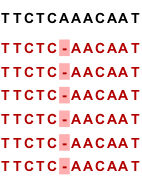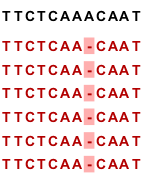Gap placement
In the case of insertions or deletions in homopolymeric or repetitive regions, the precise placement of the insertion or deletion cannot be determined from the data. An example is shown in figure 33.24.

Figure 27.8: Three As in the reference (top) have been replaced by two As in the reads (shown in red). The gap is placed towards the 5' end, but could have been placed towards the 3' end with an equally good mapping score for the read.
In this example, three As in the reference (top) have been replaced by two As in the reads (shown in red). The gap is placed towards the 5' end (left side), but could have been placed towards the 3' end with an equally good mapping score for the read as shown in figure 33.25.

Figure 27.9: Three As in the reference (top) have been replaced by two As in the reads (shown in red). The gap is placed towards the 3' end, but could have been placed towards the 5' end with an equally good mapping score for the read.
Since either way of placing the gap is arbitrary, the goal of the mapper is to place the gaps consistently at the same side for all reads.
Many insertions and deletions in homopolymeric or repetitive regions reported in the 1000 Genomes public database have been identified based on mappings done with tools like BWA and Bowtie, which place insertions or deletions at the left side of a homopolymeric tract. To help facilitate comparison of variant results with such public resources, the Map Reads to Reference tool places insertions or deletions in homopolymeric tracts at the left hand side. However, when comparing to dbsnp variant annotations, it is better to shift variants according to the 3' rule of HGVS. This can be done using the option "Move variants from VCF location to HGVS location" of the Amino Acids Changes tool.
